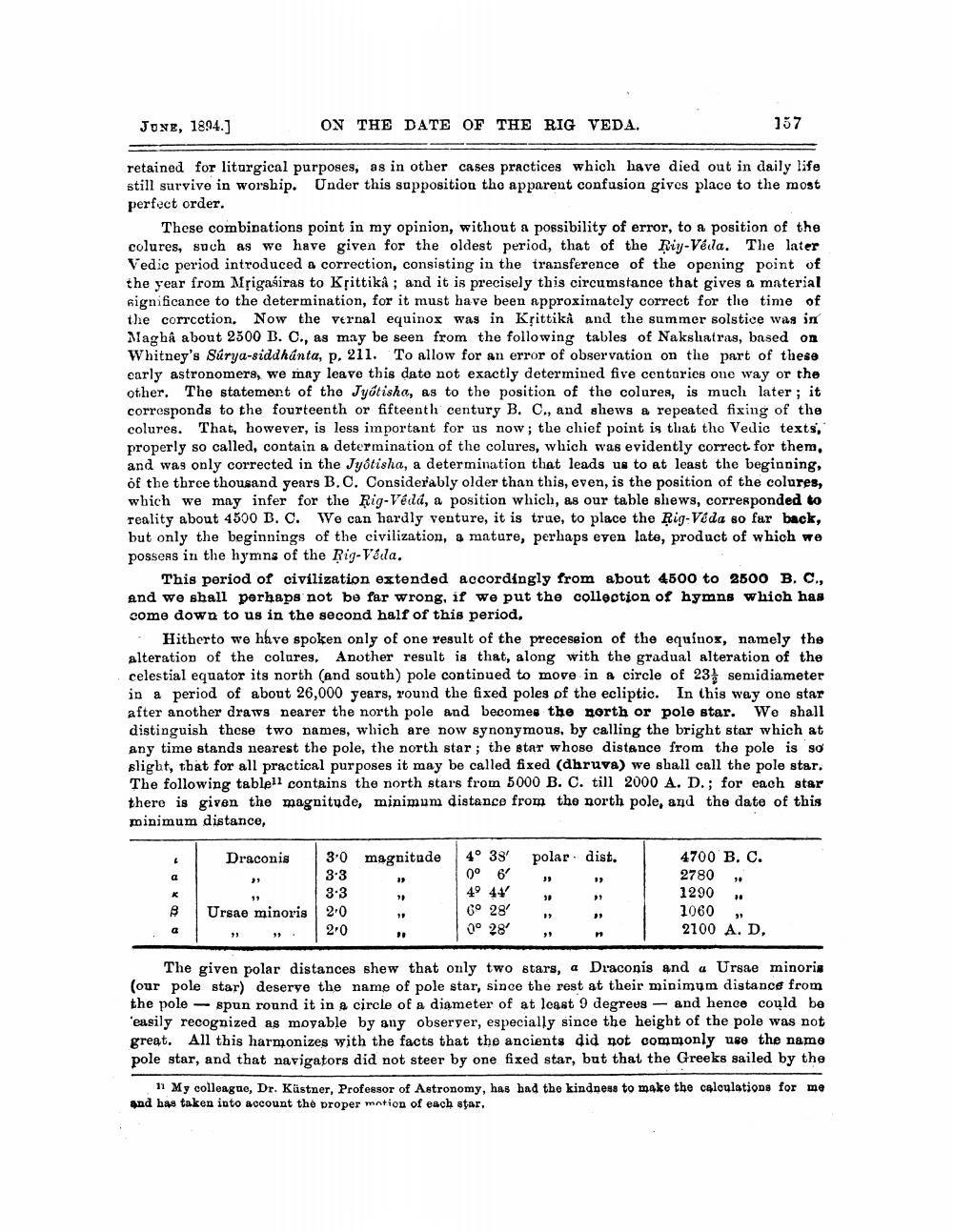________________
June, 1894.]
ON THE DATE OF THE RIG VEDA.
157
retained for liturgical purposes, as in other cases practices which have died out in daily life still survive in worship. Under this supposition the apparent confusion gives place to the most perfect order.
These combinations point in my opinion, without a possibility of error, to a position of the colures, such as we have given for the oldest period, that of the y-Véda. The later Vedic period introduced a correction, consisting in the transference of the opening point of the year from Mrigasiras to Ksittikả ; and it is precisely this circumstance that gives a material significance to the determination, for it must have been approximately correct for the time of the correction. Now the vernal equinox was in Krittiki and the summer solstice was in Maghi about 2500 B. O., as may be seen from the following tables of Nakshatras, based on Whitney's Surya-siddhanta, p. 211. To allow for an error of observation on the part of these early astronomers, we may leave this date not exactly determined five centuries one way or the other. The statement of the Jyótisha, as to the position of the colures, is much later; it corresponds to the fourteenth or fifteenth century B. C., and shews a repeated fixing of the colures. That, however, is less important for us now; the chief point is that the Vedic texts, properly so called, contain a determination of the colures, which was evidently correct for them, and was only corrected in the Jyotisha, a determination that leads us to at least the beginning, of the three thousand years B.C. Considerably older than this, even, is the position of the colures, which we may infer for the Rig-Védd, a position which, as our table shews, corresponded to reality about 4500 B. C. We can hardly venture, it is true, to place the Rig Veda so far back, but only the beginnings of the civilization, a mature, perhaps even late, product of which we possess in the hymns of the Rig Veda.
This period of civilization extended accordingly from about 4500 to 2600 B. C., and we shall perhaps not be far wrong, if we put the collection of hymns which has come down to us in the second half of this period.
Hitherto we have spoken only of one result of the precession of the equinox, namely the alteration of the colores. Another result is that, along with the gradual alteration of the celestial equator its north (and south) pole continued to move in a circle of 23% semidiameter in a period of about 26,000 years, round the fixed poles of the ecliptic. In this way one star after another draws nearer the north pole and becomes the north or pole star. We shall distinguish these two names, which are now synonymous, by calling the bright star which at any time stands nearest the pole, the north star; the star whose distance from the pole is so slight, that for all practical purposes it may be called fixed (dhruva) we shall call the pole star. The following tablell contains the north stars from 5000 B. C. till 2000 A. D.; for each star there is given the magnitude, minimum distance from the north pole, and the date of this minimum distance,
Draconis
polar dist.
ADA
3.0 magnitude | 4° 38' 33 3.3 2.0
6° 28 20
0° 28
4700 B. C. 2780 , 1290 . 1060 , 2100 A, D,
1
Ursae minoris
> >
The given polar distances shew that only two stars, a Draconis and a Ursae minoris (our pole star) deserve the name of pole star, since the rest at their minimum distance from the pole - spun round it in a circle of a diameter of at least 9 degreus - and hence could be easily recognized as moyable by any obseryer, especially since the height of the pole was not great. All this harmonizes with the facts that the ancients did not commonly use the name pole star, and that navigators did not steer by one fixed star, but that the Greeks sailed by the
11 My colleague, Dr. Küstner, Professor of Astronomy, has had the kindness to make the celoulations for me and has taken into account the proper motion of each star,




